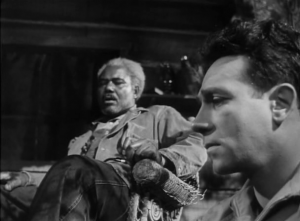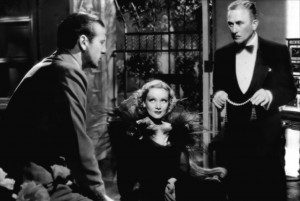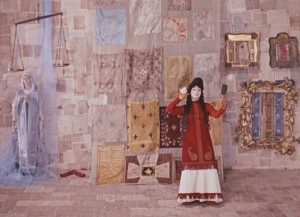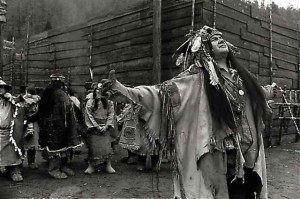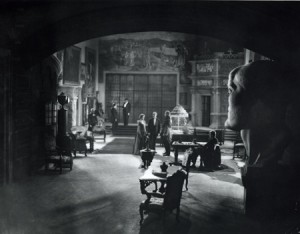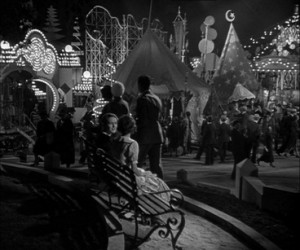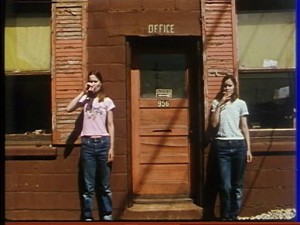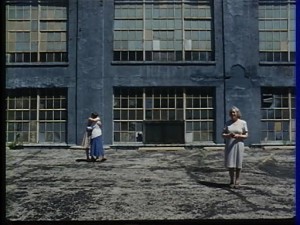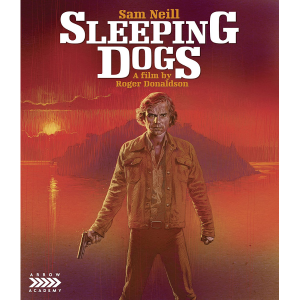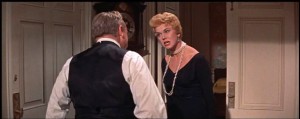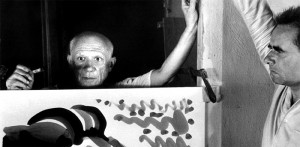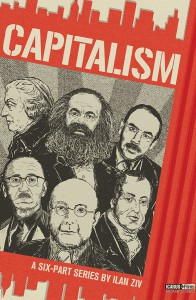From the Summer 2018 issue of Cinema Scope. — J.R.
1. Second Thoughts First
In the introduction to my forthcoming collection Cinematic Encounters: Interviews and Dialogues, I make the argument that although Truffaut’s book-length interview with Hitchcock doesn’t qualify precisely as film criticism, it nonetheless had a decisive critical effect on film taste. By the same token, on Criterion’s very welcome Blu-ray edition of Frank Borzage’s Moonrise (1958), Peter Cowie’s interview with Borzage critic/biographer Hervé Dumont — whose book on the director should be shelved and considered alongside Chris Fujiwara’s book for the same publisher (McFarland) on Jacques Tourneur — primed me perfectly for my second look at this masterpiece, and made it register far more powerfully this time. It certainly performs this task better than Philip Kemp’s accompanying essay, which, in spite of much useful information, falters in its insistence on framing Moonrise through the lens of film noir, and even more when, while rightly praising the character of Rex Ingram’s Mose, the author remarks that “It would be hard to think of another American film of the period where a black man acts as adviser and mentor to a white Southerner.” It’s not so hard, really, if one thinks of Clarence Brown’s Intruder in the Dust (1949) and/or Tourneur’s Stars in My Crown (1950); and it’s even quite easy if, following Dumont’s lead on Moonrise, one regards the Tourneur masterpiece neither as a noir (a lazy escape hatch) nor as a western (as Jacques Lourcelles does), but as a discreet form of German Expressionism, implicitly favouring thoughtful philosophy and metaphysics over simple gloom and doom.
Indeed, what could make Stars in My Crown work perfectly on a double bill with Moonrise is that both films squarely face the darkest and ugliest aspects of Southern culture—the KKK in the Tourneur, the schoolboy cruelty and the myth of tainted blood in the Borzage—before using genuine folk wisdom to arrive at an affirmative conclusion that can view the South both positively and progressively without collapsing into immoderate sentimentality. By contrast, part of what makes noir so fashionable—and which, Dumont implies, also helped to make Moonrise a commercial flop—is its cynicism and defeatism, another expedient escape hatch.
***
My favourite Borzage movie, Man’s Castle (1933), unfortunately remains available on DVD only from Spain, unless you download it from YouTube (as I did). But after I went from Moonrise to Liliom (see below), I chose to re-see Desire (1936), which can be found on either a $20 Universal Vault DVD or, for half that price, the Marlene Dietrich volume in the Universal Hollywood Icons Collection (where it’s included along with Blonde Venus, Angel, and Seven Sinners); my own copy is an Italian DVD (Desiderio), apparently no longer available, where the cinematography positively glistens. Reuniting Dietrich and Gary Cooper half a decade after Sternberg’s Morocco, Desire is an inspired collaboration between Borzage and Lubitsch: the latter had originally planned to direct until he was named Paramount’s head of production, and Dietrich selected Borzage as his replacement. Dumont persuasively argues that the first half of this gem is quintessentially Lubitschian before the Borzagean drift takes over; one might add that the point at which the two directorial styles fuse most triumphantly is the delightful morning-after sequence ihttps://www.jonathanrosenbaum.net/wp-content/uploads/2014/06/manscastle.pngn which night-before sex between the two leads is firmly established.
***
How to choose between the virtually simultaneous Blu-ray releases of Sergei Parajanov’s The Colour of Pomegranates (Sayat Nova) by Second Sight in the UK and by Criterion in the US? The latter does include a documentary about the Armenian poet Sayat Nova, but I think I’d opt for the former. (By contrast, choosing between the superb recent Blu-ray editions of Carl Dreyer’s The Passion of Joan of Arc from Masters of Cinema and Criterion is much harder, because their contents are so nearly identical.) It offers more by including two versions of the film instead of one—the Armenian version edited by Parajanov and the Russian version re-edited by Sergei Yutkevich (omitted by Criterion)—and Parajanov’s mind-boggling filmed “treatment” for his never-made Kyiv Frescoes, as well as a beautiful and fascinating 116-page illustrated book including such precious items as a 1974 letter of protest co-signed by Viktor Shklovsky and Andrei Tarkovsky and many other letters by Parajanov and others relating to the director’s imprisonment. Both releases include contributions by Tony Rayns, Parajanov scholar James Steffan, and the late filmmaker and Parajanov friend Mikhail Vartanov—though not, alas, the latter’s still-unavailable Parajanov: The Last Spring (1992), which contains the last film Parajanov ever shot: an eight-minute fragment called Confession that is, in some ways, my favourite of all his works. (According to Daniel Bird, who assembled the Second Sight set, Vartanov’s 35mm documentary—apparently the only way to see Confession—has remained perpetually out of reach because of its prohibitive cost, although I was able to see it in Chicago in early 1996 as part of a Bruce Posner program.
***
To comment briefly on two other recent Criterion Blu-rays of particular favourites of mine: (1) My only regret about the edition of Kon Ichikawa’s spectacularly exciting An Actor’s Revenge (1963) is the complete absence of any acknowledgment that the film is apparently celebrated only outside Japan; I have yet to encounter a single native critic or spectator who doesn’t consider it a potboiler of little distinction. This poses a fascinating conundrum about cultural differences, and I wonder if it can be attributed partly to Ichikawa’s background as an animator and satirist (which kept Frank Tashlin unrecognized as an artist in the US), or to the confluence of gender-bending and genre-bending that has also made George Cukor’s innovative and subversive Sylvia Scarlett (1935) misunderstood and underappreciated. (2) Having written a book about Jim Jarmusch’s Dead Man that has been published in four languages, I expected I’d be hypercritical about Criterion’s extras on the subject, but I must confess they’ve done a marvelous job with them: Amy Taubin (whom I seldom agree with) has written an excellent essay, and among the other bountiful bonuses I especially value the interview with Gary Farmer and all the material relating to Neil Young’s score.
***
According to Kino Lorber, the main attraction on their Gabe Klinger Blu-ray is Porto (2016), his uneven first fiction feature, while his first-rate documentary Double Play: James Benning and Richard Linklater (2013) is just an extra. Yet to my taste it’s the latter that makes this well worth having—though in the interests of full transparency, I should point out that Klinger showed me rough cuts of both films (two separate rough cuts in the case of Porto, a film he also asked me to co-write at an early stage), and I’m the one who came up with the title of Double Play. While all of this complicates (and perhaps undermines) my value as an impartial advisor to potential consumers, one advantage to having both films on the same Blu-ray is that it asks us to consider what they have in common. Both are less than 80 minutes long (a giant plus), and each is about two people: real filmmakers and longtime friends in Double Play, a fictional couple played by Lucie Lucas and the late Anton Yelchin in Porto. And it might be argued that the duo in each film is viewed a bit asymmetrically, with slightly more emphasis given in each case to the more solitary and less grounded person (Benning and Yelchin, respectively).
However, the reasons for this unequal emphasis are quite different, and so are the consequences. I find it both logical and reasonable that Benning, an experimental and largely non-narrative filmmaker, gets more attention than the more mainstream (though still adventurous on his own terms) Linklater, because he isn’t nearly as well-known and most of his films are much harder to see. (Despite the exemplary manner in which Edition Filmmuseum has been issuing excellent DVD editions of Benning’s work—see below for the most recent of these—he has been far too prolific in recent years for them or anyone else to keep up with him.) It’s also quite understandable that Yelchin gets more attention than Lucas, because of his untimely accidental death shortly after the film was shot—understandable yet, alas, less beneficial. I prefer the earlier cuts of Porto, in which Lucas and her character had more breathing space and Yelchin’s dated, James Dean-ish poses seemed less prominent. (In order to hold romantic narcissism in check it needs to be objectified as such, but Klinger seems to identify too closely with it to be able to critique it.) Of course, most other viewers don’t and won’t have any choices or points of comparison in this matter, so my own responses may not be very useful. In any case, I still love the piano music and the cinematography.
***
James Cruze’s The Covered Wagon (1923) was one of my preferred silent pictures during the 1960s. I haven’t had too many opportunities to revisit it since then, so I asked Kino Lorber for a review copy of their Blu-ray, and was intrigued to learn from Matt Hauske’s essay that it made almost twice as much money as Cecil B. DeMille’s original version of The Ten Commandments released the same year, and was reputed to be Warren Harding’s favourite movie. It still looks fairly awesome, and I would guess that one reason why it isn’t celebrated more these days is our spotty sense of Cruze after so many of his films (especially, it seems, his comedies) have been lost. This appears to make it a movie for action and history buffs more than aesthetes (as is suggested in both Toby Roan’s audio commentary and Lourcelles’ Dictionnaire du Cinéma), but I have to admit that, in spite of Karl Brown’s gorgeous cinematography, I only found the film fully watchable after I shut off the Roan commentary and stuck with just the Gaylord Carter organ score.
***
Although I still haven’t learned how to pronounce Casper Tybjerg’s name with any confidence, I’ve come to regard this Danish film scholar and Carl Dreyer biographer as an essential resource. Unsurprisingly, his audio commentary on the Masters of Cinema Blu-ray of Dreyer’s Michael (1924) didn’t let me down, as it deftly navigates the complex issues of how the film does and doesn’t qualify as gay, the subtle significance of Benjamin Christensen’s overacting as the elderly painter, and the kitschiness of both his character’s painting and his opulent domestic décor. But Tybjerg stops short of considering either Maurice Drouzy’s report (published in French) of Dreyer falling in love with his cinematographer Rudolph Maté (who was second camera on Michael) in the early 1930s and then suffering a nervous breakdown, or the plausible thematic link between Michael and Gertrud that’s explored in the Tom Milne essay which is included in the accompanying 56-page booklet, along with texts by Jean Renoir, Nick Wrigley, Philip Kemp, and a translated Danish programme. (Two other extras worth noting are an audiovisual essay by David Cairns and a precious 1965 audio interview in English with Dreyer himself.)
2. First Looks Second
After Moonrise whetted my appetite for more Borzage, I turned to Liliom (1930), another metaphysical/expressionist commercial flop with an equally hot-headed hero (Charles Farrell), a no-less devoted and forgiving heroine (Rose Hobart), and even more beautifully unrealistic sets that spell out the hero’s mental confinement. To look at this odd gem, I went not to the pricey Region 2 BFI release (which pairs it with Borzage’s silent 1929 Lucky Star) but to that most user-unfriendly of all box sets: Murnau, Borzage, & Fox (dutifully covered in this column in Cinema Scope 40, where it’s described as “invaluable materials, atrociously packaged”), encompassing a dozen DVDs and two coffee-table-sized books, and currently available on Amazon for $240. (I’m not at all sorry that I own this sad blunderbuss, but it’s easy to forget that I do because it’s far too unwieldy to fit on any ordinary shelf.) The strangest aspect of this sincere and eccentric early talkie, much weirder than the jokey Fritz Lang version made in France four years later, is its curious form of spaced-out dialogue delivery—“involuntarily calling to mind the distancing effects sought by Brecht,” as Dumont puts it.
***
The longest chapter in my book Film: The Front Line 1983 (which is available on my website) is devoted to James Benning, and most of its 6,000 words are about his first two feature-length films, the 77-minute 11 x 14 (1977) and the 60-minute One Way Boogie Woogie (1978). These are both included in Edition Filmmuseum’s sixth and latest two-disc Benning DVD set, comprising the former in a digital restoration and the latter accompanied by its two “remakes,” the 56-minute 27 Years Later (2005) and the 90-minute One Way Boogie Woogie 2012 (2012), the latter of which I’ve just seen for the first time. (Typically for Benning, all of the shots in all four films are taken from a stationary camera.)
Benning was teaching college math when he started making films, and numbers as well as mathematical concepts are operative in all of these works. 11 x 14 (which has more of a narrative than most of his other films) takes 11 shots from his earlier, 33-minute 8½ x 11 (1974)—one-third of its 33 one-minute shots—and uses them in a different order, “surrounded,” as Benning once put it, “by much more information, which makes it more confusing.” (8½ x 11 are the measurements of a piece of typing paper, and 11 x 14 are the measurements of a piece of photographic paper.) One Way Boogie Woogie (which is named after Piet Mondrian’s painting Broadway Boogie Woogie) consists of 60 one-minute shots filmed in Milwaukee, Benning’s hometown; 27 Years Later aims to reproduce the same camera setups in the same locations and, as much as possible, use the same people and stage the same actions; and One Way Boogie Woogie 2012 (shot digitally, unlike all the preceding films, which were shot in 16mm) includes “remakes” of only 18 of these shots, each of them five minutes long and all of them unstaged in terms of action, making the whole thing mostly interminable. (This seems deliberate, insofar as the human and/or musical interventions providing sauce and wit to many of the original shots are few and far between here, and always appear accidental rather than arranged; the only significant event in the first shot, a dull stare at two matching garage doors, is a single quickly passing car.) While 27 Years Later is appreciably less engaging than the original and 2012 still less interesting than its predecessor, all three films together provide much food for reflection, even if they are more sculpted objects for study than experiences.
***
Sleeping Dogs (1977), the first theatrical feature of both director Roger Donaldson and actor Sam Neill, is described on the jacket of the new Arrow Academy Blu-ray as “simultaneously a political thriller, a personal drama and a true landmark in New Zealand cinema”; it’s also dystopian SF (grounded in its literary origins as C.K. Stead’s Vietnam War-era novel Smith’s Dream), a better-than-average action thriller, and an all-too-familiar war picture predicated on the all-too-commercial premise of an apolitical hero (Neill, by way of Bogart in Casablanca and To Have and Have Not) gradually becoming more politically committed than anyone else in the known universe. (Countering the latter Hollywood cliché a little is a memorable anti-American cameo by the great Warren Oates, playing the most uncouth Yankee grunt imaginable.) As usual, whether he’s working with good material or unredeemable treacle, Donaldson registers as a technician and metteur en scène, not an auteur.
***
I believe that the last time I saw Charles Vidor’s Love Me or Leave Me before purchasing the Warners Archive Collection Blu-ray was in Florence, Alabama in 1955—so considering that all my molecules must be replacements now, 63 years later, I suppose this could qualify as a first look. Set in 1920s Chicago, the film is based on the sordid real-life doings of singer Ruth Etting (Doris Day), her pianist Johnny Alderman (Cameron Mitchell), and her Jewish hood manager Marty Snyder (James Cagney)—doings which have been grossly simplified to appease the censors, sometimes to the point of incoherence. Co-scripted by novelist Daniel Fuchs, the film (without the benefit of any Lubitsch/Borzage subterfuge) implicitly has Snyder doing some sort of Harvey Weinstein number on Etting while she improbably and steadfastly remains a virgin, until she marries Snyder shortly after becoming famous in the 1927 Ziegfeld Follies. (The real Etting married Snyder in 1922, divorced him in 1937, and then married Alderman the following year, while Snyder was on trial for attempting to murder him.) The style of Etting’s numbers is far less authentic than the Dixieland heard in Jack Webb’s Pete Kelly’s Blues (another 1920s gangster musical) the same year or the two Vitaphone shorts starring Etting that are included on the same Warners Blu-ray, and Snyder’s Jewishness is limited to Cagney saying “Mazel tov” at some point. But this has a certain gritty power thanks to Cagney’s firecracker energy and Day’s obvious pleasure at playing a conflicted careerist instead of her usual creampuff type. Back in the ’20s, when gangsters ran much of America and Americans had fewer qualms about admitting it than they do today, sordidness was clearly part of the lingua franca, and even without much period atmosphere Love Me or Leave Me has a fairy convincing abrasiveness which helps to justify its Oscars.
***
One reason why I never made it all the way through Henri-Georges Clouzot’s The Mystery of Picasso (1956) until Arrow Academy sent me their Blu-ray is that I could never quite get past the sheer silliness of Clouzot’s opening narration: “One would die to know what was on
Rimbaud’s mind when he wrote ‘The Drunken Boat,’ or on Mozart’s when he composed the ‘Jupiter’ Symphony….Thankfully, what is impossible to know for poetry and music is not in [sic] the case for painting. To know what’s going on through a painter’s mind one just needs to look at his hand.” Apart from seriously doubting the truth of that last sentence, I assume that what were on Rimbaud’s and Mozart’s minds were, precisely, “The Drunken Boat” and the “Jupiter” Symphony. And even if what Clouzot means is simply the process and not the substance of composition, what he delivers with the help of Picasso isn’t quite that process either, because of all the radical abridgement and speeding-up he does of Picasso’s physical activity, giving us the italicized highpoints as he sees them while editing out many of the doubts and uncertainties—a bit of a con job, in short, that seemingly turns painting into doodling.
***
Whenever I encounter the glib slogan “Piracy is not a victimless crime” on a DVD or Blu-ray, I feel like barking back “Capitalism is not a victimless crime.” If that sounds excessive to you, I take it that you haven’t yet seen Ilan Ziv’s punchy, six-part, 318-minute miniseries Capitalism, which premiered on the French ARTE channel in 2014 and is available now on a three-disc DVD package from Icarus Films; so far I’ve seen only the first two-thirds, but I’m eagerly looking forward to the rest. Even if you’re put off, as I was, by the scattershot talking-head montage that introduces each episode, as soon as the first episode gets down to hard cases—illustrating its title, “Adam Smith: The Birth of the Free Market,” by deconstructing much of the received marketplace wisdom on the subject—I’m both captivated and persuaded by the discourse. This involves unpacking our ahistorical assumptions about tribal barter, a closer look at what we mean and don’t mean by “free” (expanded upon in the following episodes), and Smith’s tactical avoidance of slavery, which has served as one of capitalism’s fundamental linchpins (and not only in relation to the historical past). Demystifying both key economic theories and their selective evolutions and perversions into marketing slogans and other deceptive catchphrases, each chapter has a cleansing and clarifying effect; among the articulate commentators (speaking in English and subtitled French, Hebrew, and Mandarin) are Noam Chomsky, James Kenneth Galbraith, Thomas Piketty, Marx biographer Mary Gabriel, activist and anthropologist David Graeber, Cambridge economist Ha-Joon Chang, and Israeli historian Yuval Noah Harari.
To a lesser extent, I was also educated historically by Felix Moeller’s Forbidden Films: The Hidden Legacy of Nazi Film (2014), released jointly on DVD by Zeitgeist Films and Kino Lorber. This depends equally on talking heads, but the presentation is clunkier (as the full title already suggests). Whereas Capitalism can be called an audiovisual essay with a distinct position and thesis of its own (akin to an Adam Curtis polemic), this is a documentary that seemingly aims to present a debate without taking sides about whether Nazi films should be banned today—and without really compelling me to choose a position either. The results are provocative, yet also, in spite of the subject matter, a bit juiceless.

